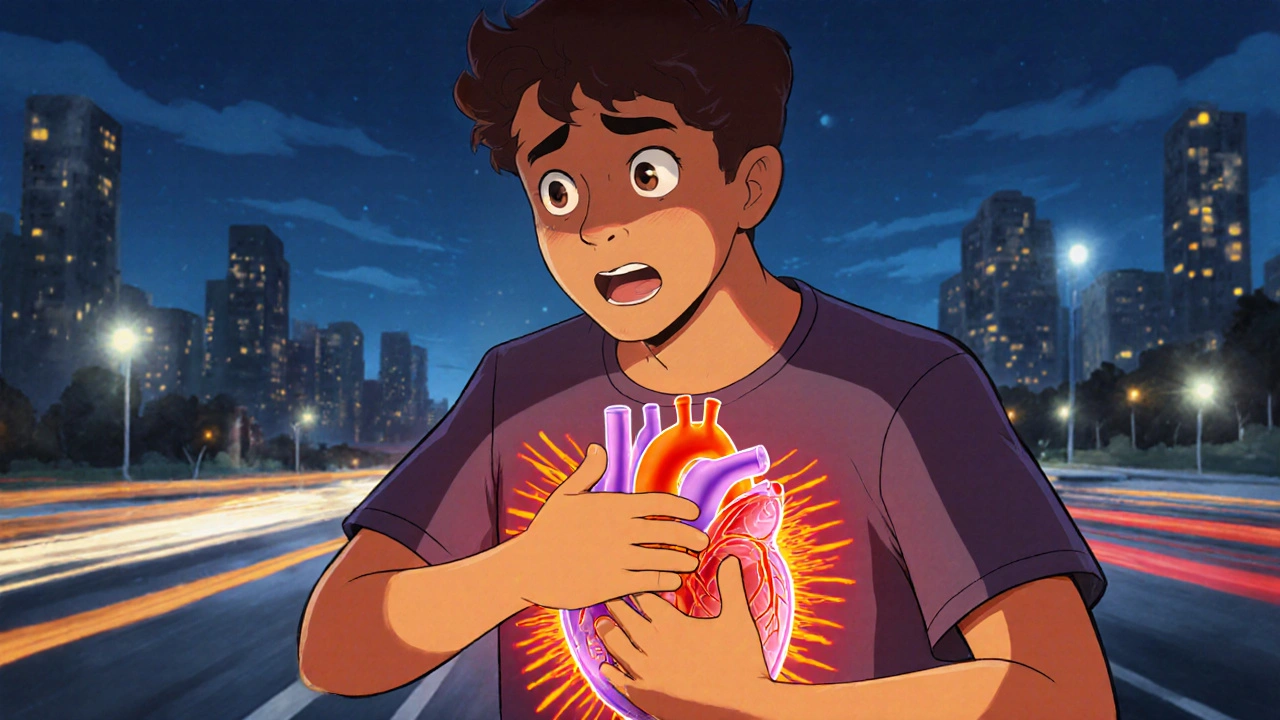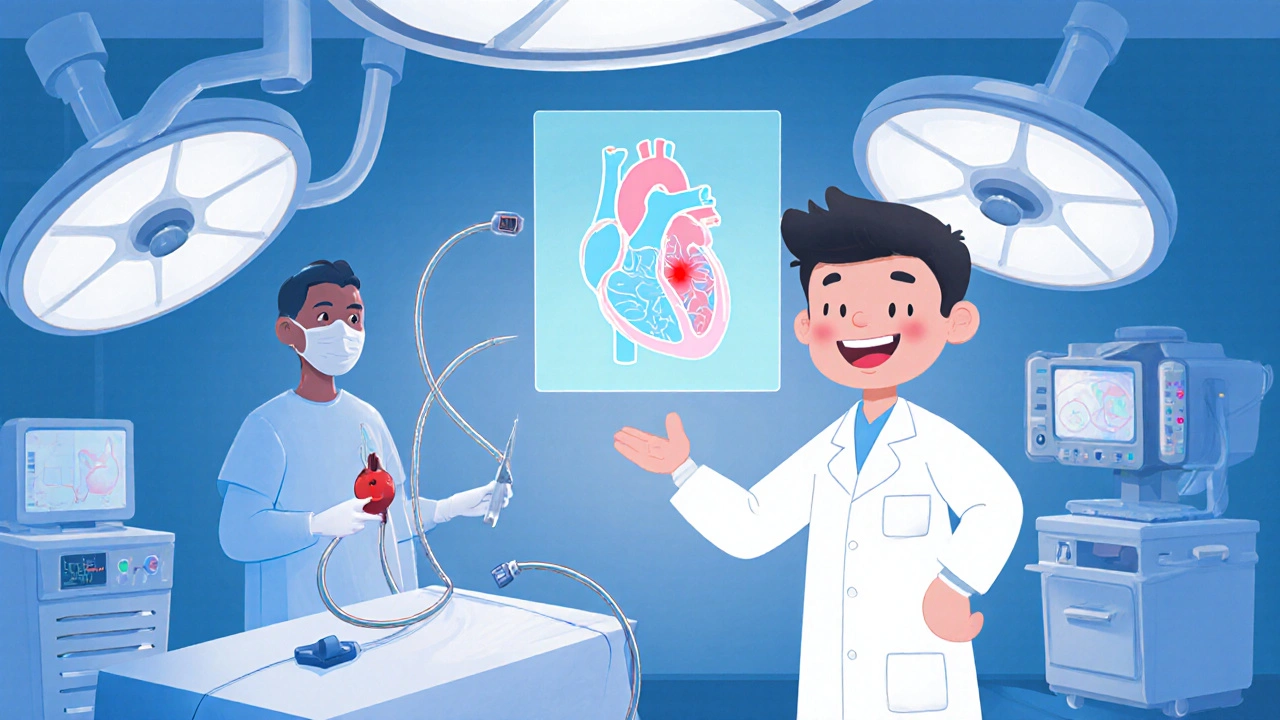Catheter Ablation: An Effective Treatment for Supraventricular Tachycardia

SVT Ablation Comparison Tool
Compare Radiofrequency vs Cryoablation
Learn how these two ablation techniques differ in effectiveness, safety, and patient experience for treating supraventricular tachycardia.
Comparison Criteria
| Radiofrequency Ablation | Cryoablation | |
|---|---|---|
| Energy Type | Heat (50-70°C) | Cold (-70°C) |
| Success Rate (AVNRT) | 95-98% | 93-96% |
| AV-Node Damage Risk | Low-moderate | Very low (reversible) |
| Procedure Time | 30-45 min | 45-60 min |
| Patient Comfort | Standard sedation | Often requires deeper sedation |
If you’ve ever felt your heart race out of control, you might have experienced supraventricular tachycardia (SVT). While medication can help, many patients wonder if there’s a more permanent fix. The answer often lies in catheter ablation, a minimally invasive procedure that targets the electrical pathways causing the rapid beats.
What Is Supraventricular Tachycardia?
SVT is a blanket term for a group of fast‑heart‑rate disorders that originate above the heart’s ventricles. The most common types include atrioventricular nodal re‑entrant tachycardia (AVNRT) and atrioventricular re‑entrant tachycardia (AVRT). Symptoms range from palpitations and shortness of breath to dizziness or even fainting. In severe cases, the heart can beat 200-250 times per minute, reducing blood flow to the brain and other organs.
How Doctors Diagnose SVT
Diagnosis begins with a careful history and a physical exam, followed by an electrocardiogram (ECG) that captures the heart’s rhythm. If the episode is intermittent, a Holter monitor a portable ECG that records heart activity for 24‑48hours can catch fleeting episodes. In more complex cases, an electrophysiology (EP) study pinpoints the exact pathway that’s sending the rapid signals.
What Is Catheter Ablation?
Catheter ablation a minimally invasive cardiac procedure that destroys abnormal heart tissue using heat or extreme cold involves threading thin, flexible catheters through a vein (usually in the groin) into the heart. Guided by real‑time imaging and electrical mapping, the physician delivers energy to the tiny area responsible for the erratic rhythm. The goal is to create a small scar that blocks the faulty pathway while preserving normal conduction.
Energy Sources: Radiofrequency vs. Cryoablation
Two main energy modalities dominate modern ablation:
| Feature | Radiofrequency (RF) Ablation | Cryoablation |
|---|---|---|
| Energy type | Heat (50‑70°C) | Cold (‑70°C) |
| Success rate for AVNRT | 95‑98% | 93‑96% |
| Risk of AV‑node damage | Low‑moderate | Very low (reversible freezing) |
| Procedure time | 30‑45min | 45‑60min |
| Patient comfort | Standard sedation | Often requires deeper sedation |
Both methods achieve excellent outcomes, but cryoablation is often preferred when the target area is close to the atrioventricular (AV) node because its effects can be tested before making the lesion permanent.

Step‑By‑Step: What to Expect During the Procedure
- Pre‑procedure fasting and medication review - doctors may hold certain blood thinners.
- Local anesthesia at the entry site, followed by mild sedation.
- Insertion of one or more electrophysiology catheters thin, sensor‑filled wires that map electrical activity inside the heart.
- Creation of a 3‑D map of the heart’s conduction system using electro‑anatomical software.
- Targeted energy delivery (RF or cryo) to the culprit pathway.
- Verification that normal rhythm is restored and that no unintended block has occurred.
- Catheters removed, pressure applied to the access site, and a short observation period (usually 4‑6hours).
Most patients go home the same day or after an overnight stay.
Success Rates and Long‑Term Outlook
Multiple studies through 2024 show a >95% acute success rate for AVNRT and >90% for AVRT when performed by experienced electrophysiologists. Recurrence is rare-typically under 5% over five years-especially when the procedure is done with advanced mapping tools.
Potential Risks and How to Minimize Them
Even the safest procedures carry some risk. Common concerns include:
- Vascular complications at the entry site (bleeding or hematoma).
- Temporary heart block requiring a pacemaker-more common with RF near the AV node.
- Rare cardiac perforation leading to pericardial effusion.
- Radiation exposure from fluoroscopy (kept low with modern 3‑D mapping).
Choosing a center with high procedural volume and experienced staff dramatically lowers these odds.

Recovery and Lifestyle After Ablation
After a successful ablation, most people feel normal within a week. Doctors typically advise:
- Avoid heavy lifting or strenuous activity for 48‑72hours.
- Stop anticoagulants only if your doctor says it’s safe.
- Resume normal medications only if symptoms recur; many patients can wean off beta‑blockers or calcium‑channel blockers.
Regular follow‑up ECGs or Holter monitoring confirm that the rhythm stays stable.
Alternatives to Catheter Ablation
If ablation isn’t an option, doctors may try medication first. Common drug classes include beta‑blockers agents that slow heart rate by blocking adrenaline receptors and calcium‑channel blockers like verapamil. In refractory cases, surgical maze procedures or a pacemaker may be considered, but these are far more invasive.
Choosing the Right Center
Selection criteria that matter:
- Electrophysiology fellowship‑trained physicians.
- Annual SVT ablation volume >100 cases (higher volume correlates with lower complications).
- Availability of both RF and cryo technology.
- Transparent outcome reporting and patient testimonials.
Ask prospective centers about their success rates, average procedural time, and post‑procedure follow‑up protocol.
Frequently Asked Questions
Is catheter ablation painful?
Pain is minimal. The catheters are inserted under local anesthesia, and most patients only feel mild pressure. Sedation helps keep you comfortable throughout.
How long does the procedure take?
Typically 30‑60minutes, depending on the complexity and the energy source used.
Can I get pregnant after ablation?
Yes. Ablation does not affect fertility, and many women safely go through pregnancy after the procedure.
What is the chance of needing a repeat procedure?
Recurrence rates are under 5% for AVNRT and about 10% for more complex SVTs. Most repeat procedures are successful the second time.
Do I need to stop my blood thinners before ablation?
Your doctor will advise a temporary pause, usually 24-48hours before the procedure, to reduce bleeding risk.



Tom Green
Catheter ablation has become a cornerstone in the management of supraventricular tachycardia for many patients.
It offers a chance to break free from the endless cycle of palpitations and medication side effects.
The procedure is performed by skilled electrophysiologists who map the heart’s electrical pathways with impressive precision.
By delivering targeted energy, whether radiofrequency heat or cryo‑freezing, they create a tiny scar that blocks the rogue circuit.
This scar is permanent yet small enough to preserve the heart’s normal conduction.
In experienced centers, success rates exceed 95 percent for AVNRT and hover around 90 percent for more complex AVRT cases.
Patients who undergo ablation often report an immediate improvement in symptoms and a return to normal daily activities.
Recovery is typically swift; most individuals can leave the hospital the same day or after an overnight stay.
The post‑procedure period calls for a brief pause on heavy lifting, but otherwise life resumes with minimal disruption.
Follow‑up appointments with ECG or Holter monitoring help confirm that the rhythm remains stable.
While no medical intervention is entirely risk‑free, the complications of ablation are rare and generally less severe than long‑term drug therapy.
Vascular issues at the entry site and transient heart block are the most common, and both are manageable with proper care.
Selecting a high‑volume center staffed by fellowship‑trained electrophysiologists further reduces these risks.
Moreover, many centers now offer both radiofrequency and cryo technology, allowing the physician to tailor the approach to each individual’s anatomy.
For patients who are wary of medication side effects or who have persistent episodes despite drugs, ablation provides a compelling, durable solution.
Ultimately, the decision should be made collaboratively with your cardiology team, weighing the benefits against the small potential hazards.
Rebecca Mitchell
Wow that's a lot of detail I feel like you could have just said the procedure works and people feel better afterwards.
Patricia Echegaray
Listen, the whole thing sounds like a slick PR push by the MedTech lobby-big pharma wants us to think cutting a tiny hole in our hearts is the only way out.
They hide the truth that most of these ablations are funded by shadowy government contracts and that the data is filtered through a veil of corporate secrecy.
And don’t get me started on how they’ll ship the equipment from overseas factories, compromising national health security.
This is why we need to stay vigilant and demand transparency before we let these high‑tech gizmos into our bodies.
Miriam Rahel
While the overview is comprehensive, it neglects to address the nuanced variability in operator experience, which significantly influences complication rates.
Furthermore, the comparative analysis of radiofrequency versus cryoablation could benefit from a more rigorous statistical framework.
Overall, the piece serves as a useful introduction but would be strengthened by these additional considerations.
Samantha Oldrid
Sure, because slicing tiny scars in your heart is exactly what we all wish for on a lazy Sunday.
James Falcone
Patriotically speaking this is why our home‑grown med‑tech industry should keep the labs local and not hand over our hearts to foreign hands.
Frank Diaz
One might contemplate the metaphorical resonance of implanting a permanent scar upon the heart’s rhythm-a reminder that even our most vital organs are not immune to the indelible marks of intervention.
Yet, in the grand tapestry of existence, such lesions are merely fleeting whispers against the backdrop of life's ceaseless tempo.
We must therefore weigh the transient discomfort against the promise of liberating the soul from relentless tachycardic tyranny.
In doing so, the physician becomes not just a technician, but an arbiter of destiny, shaping the very cadence of human experience.
Mary Davies
Oh, the very thought of a scar inside the heart-how dramatically poetic!
It feels as though the chest itself becomes a stage where the drama of life and death is enacted, each beat a line of verse.
Yet beneath the theatrics lies a sobering truth: the procedure can restore normalcy and silence the relentless drum of anxiety.
Thus, while the imagery may stir the soul, the outcome is profoundly practical.
Valerie Vanderghote
I have to say, reading through the entire protocol makes me feel like I'm being guided through a very intricate maze, and honestly, it’s a bit overwhelming the way every single step is laid out in such exhaustive detail.
First, there’s the fasting and medication review, which seems straightforward, but then you have to consider the myriad exceptions for patients on anticoagulants, and that alone could fill a thousand‑page manual.
Next comes the local anesthesia and sedation, which, let’s be real, sounds like a pleasant little nap, yet the anxiety of having a catheter threading through your veins can be quite unnerving for the average person.
Then they talk about the creation of a 3‑D map of the heart’s conduction system-imagine the amount of technology and expertise required just to visualize something the size of a pea!
After that, they deliver energy-either heat or cold-to the culprit pathway, and they’re so meticulous about verifying that normal rhythm is restored, which is reassuring but also adds another layer of complexity.
I’m also fascinated by the listed success rates, because a 95‑98% acute success sounds almost too good to be true, especially when you consider the variability in operator skill.
And let’s not forget the risks-vascular complications, temporary heart block, rare perforations-all of which are expertly mitigated by choosing high‑volume centers, a recommendation that feels like a subtle nod to the fact that not every hospital can claim such expertise.
All in all, while the procedure appears safe and effective, the sheer volume of information, the emotional toll of invasive monitoring, and the reliance on cutting‑edge tech make this a decision that should not be taken lightly.
Michael Dalrymple
It is encouraging to hear such detailed insights, and I would like to underscore the importance of patient education throughout this journey.
Encouraging patients to ask questions and fully understand each procedural step can greatly reduce anxiety.
Moreover, aligning post‑procedure follow‑up with a supportive care plan ensures long‑term success and satisfaction.
Thank you for sharing this comprehensive overview.
Richard O'Callaghan
hey i read the post and i think i got it right so the doctors goo in the groin an d slide the cathetr into the heart i hope they dont break anything its kinda scary but they say it works